- 54th Regiment Massachusetts Volunteer Infantry
-
54th Regiment Massachusetts Volunteer Infantry 
The 54th Massachusetts at the Second Battle of Fort Wagner, July 18, 1863Active March 13, 1863 to August 4, 1865 Allegiance United States (Union) Branch Union Army Type Infantry Size 1,100 Nickname 54th Massachusetts Regiment Engagements American Civil War - Battle of Grimball's Landing
- Second Battle of Fort Wagner
Commanders Colonel Robert Gould Shaw Colonel Edward Needles Hallowell The 54th Regiment Massachusetts Volunteer Infantry was an infantry regiment that saw extensive service in the Union Army during the American Civil War. The regiment was one of the first official black units in the United States during the Civil War. 1st South Carolina Volunteers (Union) recruited from freed slaves, was the first Union Army regiment organized with African American soldiers in the Civil War, though many had fought in the American Revolution and the War of 1812 on both sides.
Contents
History
The regiment was authorized in March 1863 by the Governor of Massachusetts, John A. Andrew. Commanded by Colonel Robert Gould Shaw, it sprang to life after the passage of the Emancipation Proclamation. Secretary of War Edwin M. Stanton decided white officers would be in charge of all "colored" units. Colonel Shaw was hand picked by Governor John Andrew. Governor Andrew also selected Norwood Penrose "Pen" Hallowell as the unit's second in command, a rank of Lieutenant Colonel.[1] Like many officers of regiments of African-American troops, both Shaw and Hallowell were promoted several grades, both being captains at the time. The rest of the officers were evaluated by Shaw and Hallowell. Many of these officers were of abolitionist families and several were chosen by Governor Andrew himself. Lt. Col. Norwood Hallowell was joined by his younger brother Edward Needles Hallowell who was eventually appointed major in the regiment and would later command it after Shaw's death. 24 of the 29 officers were veterans, but only six had been previously commissioned.
The soldiers were recruited by white abolitionists (including Shaw's parents). These recruiters included Lieutenant J. Appleton,[2] also the first man commissioned in the regiment, whose recruiting efforts included posting a notice in the Boston Journal[3] and holding a recruiting rally held in Joy Street Church and in which speakers Edward L. Pierce and Wendell Phillips encouraged free blacks to enlist for the regiment. This recruitment group was later known as "The Black Committee".
The 54th trained at Camp Meigs in Readville near Boston. While there they received considerable moral support from abolitionists in Massachusetts including Ralph Waldo Emerson. Material support included warm clothing items, battle flags and $500 contributed for the equipping and training of a regimental band.[1] As it became evident that many more recruits were coming forward than were needed the medical exam for the 54th was described as "rigid and thorough" by the Massachusetts Surgeon-General. This resulted in what he described as the most "robust, strong and healthy set of men" ever mustered into service in the United States. Despite this, as was common in the Civil War, a few men died of disease prior to the 54th's departure from Camp Meigs.
By most accounts the 54th left Boston with very high morale. This was despite the fact that Jefferson Davis' proclamation of December 23, 1862 effectively put both African-American enlisted men and white officers under a death sentence if captured. The proclamation was affirmed by the Confederate Congress in January 1863 and turned both enlisted soldiers and their white officers over to the states from which the enlisted soldiers had been slaves. As most Southern states had enacted draconian measures for "servile insurrection" after Nat Turner's Rebellion the likely sentence was a capital one.[4]
Although the 54th left Boston hoping to fight for the Union on May 28, 1863, it started off performing only manual labor. The regiment gained notoriety in a raid on the town of Darien, Georgia, after being ordered to loot and burn the town by Col. James Montgomery. However, the 54th's participation in this raid was minimal and reluctant and Colonel Shaw initially objected to what he called a "satanic action".
The regiment's first battlefield action took place in a skirmish with Confederate troops on James Island, South Carolina, on July 16. The regiment stopped a Confederate assault, losing 42 men in the process, most notably Kyree Fuller.
The regiment gained recognition on July 18, 1863, when it spearheaded an assault on Fort Wagner near Charleston, South Carolina. At this battle, Colonel Shaw was killed, along with 29 of his men. 24 more later died of wounds, 15 were captured, 52 were missing in action and never accounted for, and 149 were wounded.[5] The total regimental casualties of 272 would be the highest total for the 54th in a single engagement during the war. Although Union forces were not able to take and hold the fort (despite taking a portion of the walls in the initial assault), the 54th was widely acclaimed for its valor during the battle, and the event helped encourage the further enlistment and mobilization of African-American troops, a key development that President Abraham Lincoln once noted as helping to secure the final victory. Decades later, Sergeant William Harvey Carney was awarded the Medal of Honor for grabbing the U.S. flag as the flag bearer fell, carrying the flag to the enemy ramparts and back, and saying "Boys, the old flag never touched the ground!" While other African-Americans had since been granted the award by the time it was presented to Carney, Carney's is the earliest action for which the Medal of Honor was awarded to an African-American.
Ironically, during the week leading up to the 54th's heroic sacrifice near Charleston, simmering racial strife climaxed in the New York Draft Riots. African-Americans on the city's waterfront and Lower East Side were beaten, tortured, and lynched by white mobs angered over conscription for the Union war effort. These mobs directed their animosity toward blacks because they felt the Civil War was caused by them. However, the bravery of the 54th would help to assuage anger of this kind.
Under the command of now-Colonel Edward Hallowell, the 54th fought a rear-guard action covering the Union retreat at the Battle of Olustee. As part of an all-black brigade under Col. Alfred S. Hartwell, they unsuccessfully attacked entrenched Confederate militia at the November 1864 Battle of Honey Hill. In mid-April 1865, they fought at the Battle of Boykin's Mill, a small affair in South Carolina that proved to be one of the last engagements of the war.
Pay controversy
The enlisted men of the 54th were recruited on the promise of pay and allowances equal to their white counterparts. This was supposed to amount to subsistence and $13 a month. Instead African-American soldiers were paid $10 a month with $3 withheld for clothing, equaling $7 in the end of the month. (White troops had nothing withheld from their monthly pay for clothing.) Colonel Shaw and many others immediately began protesting the measure. Although the state of Massachusetts offered to make up the difference in pay, on principle, a regiment-wide boycott of the pay tables on paydays became the norm.
After Shaw's death at Fort Wagner, Colonel E. N. Hallowell took up the fight to get back full pay for the troops. His second in command, Lt. Col. Hooper, took command of the regiment on June 18, 1864 after Hallowell was granted permission to proceed North to press the claims of the regiment for equal pay in person. After nearly a month Colonel Hallowell returned on July 16. Finally the U.S. Congress took action and on September 28, 1864, the men of the 54th were paid from enlistment, most after 18 months of service.
The Congressional bill authorized equal and full pay to those enlisted troops who were free men as of April 1864. Of course not all the troops qualified. Colonel Hallowell, a Quaker, rationalized that because he did not believe in slavery he could therefore have all the troops swear that they were free men. Before being given their back pay the entire regiment was administered what became known as "the Quaker oath."[citation needed] Colonel Hallowell skillfully crafted the oath to say: “You do solemnly swear that on or before the 19th day of April 1864, no man had the right to demand unrequited labor of you so help you lord.”[citation needed] Hallowell wrote a typo in his hand-written transcript of the oath and actually said "1861" while administering the oath.
Refusing their reduced pay became a point of honor for the men of the 54th. In fact, at the Battle of Olustee, when ordered forward to protect the retreat of the Union forces, the men moved forward shouting, "Massachusetts and Seven Dollars a Month!" Unknown to them, Congress had just voted to pay colored troops the same as white troops.
Legacy
 Memorial to Robert Gould Shaw and the 54th Massachusetts Volunteer Infantry Regiment by Augustus Saint-Gaudens
Memorial to Robert Gould Shaw and the 54th Massachusetts Volunteer Infantry Regiment by Augustus Saint-Gaudens
The regiment was disbanded after the Civil War, but retains a strong legacy. A monument, constructed 1884–1898 by Augustus Saint-Gaudens on the Boston Common, is part of the Boston Black Heritage Trail. A famous composition by Charles Ives, "Col. Shaw and his Colored Regiment", the opening movement of Three Places in New England, is based both on the monument and the regiment.
Colonel Shaw and his men also feature prominently in Robert Lowell's Civil War Centennial poem "For the Union Dead" (1964); Lowell invokes the realism of the Saint-Gaudens monument:
- Two months after marching through Boston,
- half the regiment was dead;
- at the dedication,
- William James could almost hear the bronze Negroes breathe.
Later he unflinchingly looks at Shaw's and his men's death:
- Shaw's father wanted no monument
- except the ditch,
- where his son's body was thrown
- and lost with his "niggers."
A Union officer had asked the Confederates at Battery Wagner for the return of Shaw's body but was informed by the Confederate commander, Brigadier General Johnson Hagood, "We buried him with his niggers."[6] Shaw's father wrote in response that he was proud that Robert, a fierce fighter for equality, had been buried in that manner.[7] "We hold that a soldier's most appropriate burial-place is on the field where he has fallen".[citation needed] As a recognition and honor, at the end of the Civil War, the 1st South Carolina Volunteers, and the 33rd Colored Regiment were mustered out at the Battery Wagner site of the mass burial of the 54th Massachusetts.
More recently, the story of the unit was depicted in the 1989 Academy Award winning film Glory starring Matthew Broderick as Shaw, Denzel Washington as Private Tripp, Morgan Freeman, Cary Elwes, Jihmi Kennedy and Andre Braugher. The film re-established the now-popular image of the combat role African-Americans played in the Civil War, and the unit, often represented in historical battle reenactments, now has the nickname The Glory Regiment.
Years after the film was made, it came to light that the word Glory was used by one of the men of the regiment. First Sergeant Robert John Simmons, of B Company, was a twenty-six year old Bermudian clerk, probably from St. George's, believed to have joined the 54th on 12 March 1863 (Many black and white Bermudians fought for the Union, mostly in the U.S. Navy.[8])
Simmons was introduced to Frances George Shaw, father of Col. Shaw, by William Wells Brown, who described him as "a young man of more than ordinary abilities who had learned the science of war in the British Army". In his book, The Negro in the American Rebellion, Brown said that "Frances George Shaw remarked at the time that Simmons would make a 'valuable soldier'. Colonel Shaw also had a high opinion of him." Sgt. Simmons was mentioned in an 1863 article of the Weekly Columbus Enquirer, which described him as "a brave man and of good education. He was wounded and captured. Taken to Charleston, his bearing impressed even his captors. After suffering amputation of the arm, he died there." The newspaper also described him as saying that he fought "for glory": One of the negroes is a remarkably sprightly fellow from Bermuda where he was educated as a soldier. His position is that of an Orderly Sergeant, but he has lost an arm, and probably one leg will go.
A third of the 'glory' for which he says he came to fight, being thus amputated, he will in the future be a wiser man. The others are a mongrel set of trash and very fair representatives of the common type of free Northern negro." Simmons, who would be specially mentioned by Shaw's successor, Col. Hallowell, and who had been awarded a private medal, died in August 1863, following the attack on Fort Wagner.[9][10]
2008 reactivation
The unit was reactivated on November 21, 2008 to serve as the Massachusetts National Guard ceremonial unit to render military honors at funerals and state functions.[11] The new unit is now known as the 54th Massachusetts Volunteer Regiment.
Footnotes
- ^ a b Emilio, Luis F. (1995). A Brave Black regiment: the history of the Fifty-Fourth Regiment of Massachusetts Volunteer Infantry, 1863-1865. Shmegma: Da Capo Press. pp. 4. ISBN 0-306-80623-1.
- ^ Burchard, Peter (1989). One gallant rush: Robert Gould Shaw and his brave Black Regiment... New York: St. Martin's Press. pp. 77–78. ISBN 0-312-04643-X.
- ^ Boston Journal, 16 February 1863 issue, reads: "To Colored Men: Wanted. Good men for the Fifty-Fourth Regiment of Massachusetts Volunteers of African descent, Col. Robert G. Shaw (commanding). $100 bounty at expiration of term of service. Pay $13 per month, and State aid for families. All necessary information can be obtained at the office, corner Cambridge and North Russell Streets."
- ^ "Jefferson Davis's Proclamation Regarding Captured Black Soldiers, December 23, 1862". University of Maryland, College Park. http://www.history.umd.edu/Freedmen/pow.htm. Retrieved 2008-07-18.
- ^ "Exhibit: 54th Mass Casualty List". National Archives and Records Administration. 1996. http://www.archives.gov/exhibits/american_originals/54thmass.html. Retrieved 2008-07-18.
- ^ Burchard, Peter (1989). One gallant rush: Robert Gould Shaw and his brave Black Regiment. New York: St. Martin's Press. pp. 143. ISBN 0-312-04643-X.
- ^ Buescher, John. "Robert Gould Shaw." Teachinghistory.org. Accessed 12 July 2011.
- ^ "Fighting to save America's soul" (Newspaper article). The Royal Gazette. August 9, 2008. http://www.royalgazette.com/article/20080809/ISLAND/308099993. Retrieved 2008-08-10.
- ^ Brown, William A. (1867). The Negro In The American Rebellion. Detroit: Thomson Gale. ISBN 1-4328-1422-2.
- ^ "The Royal Gazette: Historian hopes to write 'Glory' book". The Royal Gazette. http://www.theroyalgazette.com/siftology.royalgazette/Article/article.jsp?articleId=7d2670e30030036§ionId=60.
- ^ CBS4 Boston
Further reading
- Cox, Clinton (2007). Undying Glory: The Story of the Massachusetts 54th Regiment. Backinprint.com. ISBN 0-595-45116-0.
- Duncan, Russell; Shaw, Robert (1999). Blue-Eyed Child of Fortune: The Civil War Letters of Colonel Robert Gould Shaw. Athens: University of Georgia Press. ISBN 0-8203-2174-5.
External links
- "Louisiana and Massachusetts - Abraham Lincoln and Freedom". The Lincoln Institute. 2008. http://www.mrlincolnandfreedom.org/inside.asp?ID=54&subjectID=3. Retrieved 2008-07-18.
- "Exhibit: 54th Mass Casualty List". National Archives and Records Administration. 1996. http://www.archives.gov/exhibits/american_originals/54thmass.html. Retrieved 2008-07-18.
- 54th Massachusetts at the Battle of Olustee
- Photograph of Sgt. Major Lewis Douglass
- Photograph of Charles Douglass
Categories:- African American units of the American Civil War
- Massachusetts Civil War regiments
- Military units and formations disestablished in 1865
- Military units and formations established in 1863
Wikimedia Foundation. 2010.




